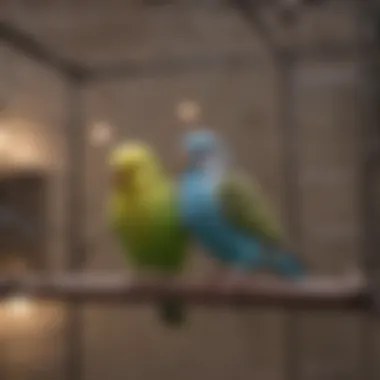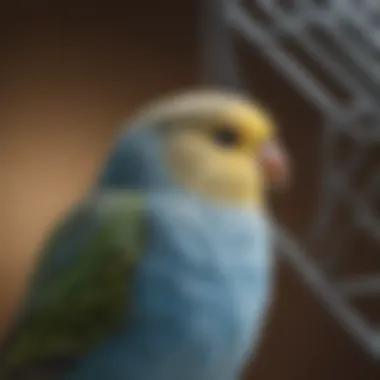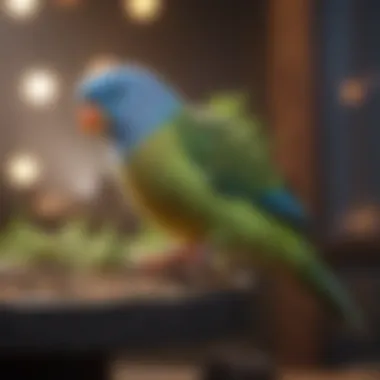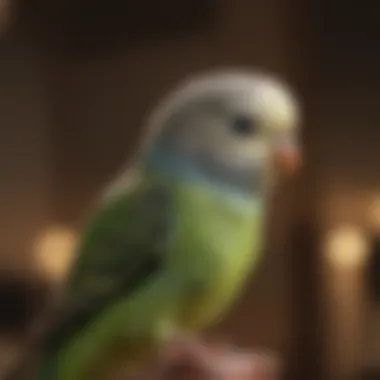Key Factors for Choosing the Perfect Budgerigar Cage


Intro
Caring for a budgerigar involves various aspects, especially when choosing the right cage. A suitable cage is not just a container; it serves as a home that affects the bird’s overall health and happiness. To provide optimal care, understanding your pet's needs is essential. This guide covers key elements in selecting and maintaining a budgerigar cage while ensuring your bird's well-being.
Understanding Your Pet
Pet Behavior Basics
Budgerigars are social and curious birds. They thrive on interaction, both with humans and with other birds. Observing their behavior can guide you in creating a suitable environment. They often display a range of actions, from singing to playful flying. Recognizing these behaviors helps in ensuring their emotional well-being.
Common Breed Characteristics
The budgerigar, or budgie, originated from Australia but is now a beloved pet worldwide. Budgies are small, typically measuring about 7 inches long. They come in various colors, which can indicate different mutations. It's good to know that they are naturally active and require plenty of space and mental stimulation in their cages.
Species-Specific Needs
Each budgerigar has unique needs. Providing ample space, suitable perches, and toys designed for their size is essential. The cage must be wider than it is tall, allowing them to fly horizontally. A suitable cage is key to their physical and psychological health, enabling exploration and play.
Pet Care and Maintenance
Feeding Guidelines
Maintaining a balanced diet is crucial for budgerigars. A mix of quality seed, pellets, fresh fruits, and vegetables supports their health. Avoid overcrowding the diet with seeds alone; it can lead to nutritional deficiencies. Fresh water should always be available, and bowls must be cleaned regularly.
Grooming Essentials
Grooming involves more than just checking feathers. Budgerigars need regular nail trimming and occasional baths. A shallow bowl of water can encourage them to bathe, which keeps their feathers clean and healthy.
Hygiene Practices
Keeping the cage clean is vital. Frequent spot cleaning and weekly deep cleaning help prevent illness. Remove old food, droppings, and soiled bedding. A disinfectant safe for birds can make the process more effective.
Training and Development
Basic Commands and Skills
Training budgerigars can be rewarding. Start with simple commands like
Factors to Consider When Choosing a Budgerigar Cage
Choosing the right cage for your budgerigar is crucial for ensuring its well-being and happiness. The selection process involves multiple factors, each contributing significantly to the overall quality of life for these birds. Not only does a suitable cage provide a safe environment, it also encourages natural behaviors and activity levels. The following subsections outline essential considerations that pet owners must take into account.
Cage Size Requirements
Minimum dimensions for budgerigars
The minimum cage dimensions for budgerigars typically should be at least 18 inches wide, 18 inches deep, and 24 inches tall. This sizing allows for basic movement and comfort. A larger cage contributes substantially to overall bird health by facilitating more natural behavior. Ensuring adequate space decreases stress and promotes better physical condition.
Space for movement and exercise
Space for movement is vital since budgerigars are naturally active creatures. They require room to spread their wings, fly short distances, and engage in climbing activities. Providing enough space encourages exercise, promoting physical and mental health. An appropriately sized cage prevents obesity and related health issues, which are often seen in smaller enclosures.
The importance of a multi-level cage
Multi-level cages are important for budgerigars as they allow for vertical movement. Birds enjoy perching at varying heights, giving them the opportunity to engage with their environment. A multi-level design also increases usable space without increasing the cage's footprint. This can be beneficial in smaller living areas where horizontal space is limited. Such designs help replicate a more natural habitat while catering to your bird's instinctual behaviors.
Material and Build Quality
Safety of different materials
Material safety is a primary concern when selecting a budgerigar cage. Metals used in construction should be non-toxic and corrosion-resistant, such as stainless steel or powder-coated finishes. Avoid cages made with galvanized metals, as they can pose health risks to birds. Assessing the safety of materials prevents potential chemical exposure, promoting a safer living space for your pet.
Durability and maintenance considerations
The durability of the cage is another factor to evaluate carefully. Materials need to withstand the wear and tear associated with active birds. Cages made from high-quality metal or heavy-duty plastic offer a longer lifespan. Maintenance should also be easy; cages that require complex cleaning processes can be cumbersome. Simplicity in design aids in daily upkeep and ensures a hygienic environment.
Choosing non-toxic finishes
When choosing a cage, non-toxic finishes are a critical aspect. It is vital to select paints, coatings, or varnishes that do not release harmful chemicals. Look for labels that indicate non-toxic materials. This ensures your budgerigar's health is protected from potential toxins, creating a safer habitat that supports its well-being.
Cage Design and Layout


Importance of horizontal space
Horizontal space is important for budgerigars, as they prefer to fly and explore sideways. Cages should have ample width to facilitate this movement. Cages with better horizontal space allow for more creative layout possibilities. Adding perches and toys in wider cages encourages multiple activities that stimulate mental engagement and darting around.
Cage bar spacing and its impact
The spacing between cage bars is critical for safety and comfort. Proper spacing prevents the budgerigar from getting stuck, while also ensuring the bird cannot escape. A bar spacing of 0.5 to 0.75 inches is generally safe for most budgerigars. Too wide a spacing may risk accidents while too narrow might restrict their freedom. Evaluating bar spacing is a simple yet important step in choosing a cage that secures your bird while promoting its comfort.
Design features that cater to budgerigar behavior
Cage designs that include features accommodating budgerigar behavior are favorable. Structures designed for landing, climbing, and foraging mimic their natural habitat. Such features include shelves, ladders, and multiple perches. These elements encourage exploration and interacting with their surroundings, ultimately creating a healthier and more stimulating environment for the birds.
Essential Accessories for Budgerigar Cages
Choosing the right accessories is crucial for the overall well-being of budgerigars. These birds require more than just a cage; they need an environment that stimulates their natural behaviors. Proper accessories can help create that environment, resulting in happier, healthier pets. A few key areas to consider are perches and platforms, food and water dispensers, as well as toys and enrichment options. Each accessory plays a distinct role in the bird's habitat, promoting activity and comfort.
Perches and Platforms
Types of perches suitable for budgerigars
When selecting perches, it is vital to choose those that suit the needs of budgerigars. Natural wood perches are often preferred due to their irregular surfaces, which allow birds to maintain foot health. These perches simulate a natural setting, offering a place to explore and rest. Plastic and cement perches also serve a purpose but can be less comfortable over time. The key characteristic of natural wood perches is the ability to provide varied diameter options, promoting foot exercise.
Placement strategies for perches
The placement of perches affects how budgerigars engage with their environment. It's beneficial to place perches at different heights and locations inside the cage. This setup should encourage climbing and movement. Perches near food and water sources help ease access but must also be positioned away from waste areas. This strategy helps maintain cleanliness and comfort within the cage. The unique feature of varied perch placement is the opportunity for exercise, key to ensuring the bird remains active.
Importance of varied perch sizes
Varied perch sizes contribute significantly to budgerigar health and activity levels. Different sizes allow birds to exercise their feet, reducing the risk of foot-related issues. Likewise, providing perches made from different materials can stimulate their interest and engagement. Wider perches can be relaxing spots, while narrower ones encourage perching and balance training. Having multiple sizes within the same environment is vital, as it caters to the bird's natural instincts for exploration and comfort.
Food and Water Dispensers
Choosing the right feeders
Choosing the right feeders impacts not only diet but also stress levels in budgerigars. Seed feeders that allow for easy access are often preferred, as they encourage natural foraging behaviors. Look for designs that prevent seed spillage; this helps maintain cleanliness in the cage. A key characteristic of well-designed feeders is their ability to keep seed fresh and avoid contamination from waste. Thus, choosing the right feeders contributes positively to their nutrition and overall health.
Water container considerations
Water is essential for the well-being of budgerigars, making container choice critical. Water containers should be easy to clean and refill without creating excess mess. Many owners opt for water bottles with a sipper tube to avoid contamination from debris. However, bowls offer birds a natural drinking method. The choice between these options depends on the owner's preference for simplicity versus the bird's natural behavior preference. A clean water source is imperative for hydration and overall health.
Maintaining hygiene in food and water systems
Hygiene plays a fundamental role in preventing diseases. Regular cleaning of food containers and water systems is essential to remove spoilage. Using safe cleaning agents is vital to ensure there are no harmful residues left behind. A good practice is to clean these items daily or every few days, depending on usage. Maintaining hygiene not only contributes to health but also ensures that the living environment is pleasant. This factor is often overlooked but should not go unaddressed.
Toys and Enrichment Options
Types of toys suited for budgerigars
Toys provide essential mental and physical stimulation for budgerigars. Chewing toys made from safe materials encourage natural behaviors, while interactive toys facilitate exploration. Hanging toys can stimulate curiosity; however, it is crucial they are sturdy enough for active birds. The key characteristic of suitable toys is their ability to engage and meet the needs of budgerigars. They must be safe, colorful, and durable to hold the birds’ attention over time.
Positioning toys for optimal interaction
Strategically placing toys in the cage can encourage interactive play. Toys should be located at various levels to promote climbing and movement. Positioning some toys near perches can invite the birds to engage more actively with them. The unique feature of this strategy lies in creating an engaging environment that mimics natural habitats. Proper placement can lead to increased activity, thus promoting overall health.
Rotating toys for mental stimulation
Rotating toys is an excellent method for providing ongoing mental stimulation to budgerigars. This approach keeps the environment fresh and encourages curiosity. Introducing new toys at intervals helps maintain interest and prevents boredom. The key characteristic of a rotating system is its adaptability, allowing for dynamic interactions. This can lead to reduced stress levels and healthier behaviors over time.
There's no single right choice when it comes to accessories for your budgerigar's cage. Every detail counts in creating an enriching environment that promotes well-being. Careful consideration of these elements ensures that your birds thrive in a safe and stimulating habitat.
Maintaining a Healthy Living Environment
Maintaining a healthy living environment is crucial for the well-being of budgerigars. Birds are sensitive creatures, and their surrounding can significantly affect their physical and mental health. A clean, safe, and appropriately positioned cage can lead to a happier and more active budgerigar. Ensuring that their living space meets specific standards benefits not just the bird but also enhances the owner's experience with their pet.
Routine Cleaning Practices
Frequency of cleaning
Regular cleaning is essential for budgerigar cages to prevent the buildup of waste and bacteria. It is recommended to clean the cage at least once a week, while spot-cleaning should be done daily. This regularity helps to maintain hygiene and ensures that the environment remains healthy. A clean space can reduce the risk of diseases that may arise from unclean conditions, thus contributing to the overall goal of keeping your budgerigar healthy. The unique feature of establishing a cleaning routine is that it facilitates a healthier environment, and fosters a stronger bond between the pet and the owner.
Safe cleaning agents
When choosing cleaning agents, safety is paramount. Use non-toxic, bird-safe products to clean the cage. Many household cleaners contain chemicals that could harm your budgerigar. Vinegar and baking soda are popular choices because they are effective and safe when used appropriately. These natural cleaners can effectively neutralize odors and sanitize surfaces without exposing the birds to harmful substances. However, it is essential to rinse the surfaces well to remove any residue after cleaning.


Sanitizing feeding utensils
Feeding utensils should also be sanitized regularly to maintain the health of your budgerigar. Wash food and water dishes daily to prevent mold and bacterial growth. Using mild soap and rinsing thoroughly before refilling with food or water is essential. A clean feeding area reduces the risk of digestive issues in your bird. Thus, establishing a routine for cleaning utensils is a beneficial choice for your bird's health.
Positioning the Cage
Optimal locations within the home
The cage's location in your home can have a significant impact on the bird's quality of life. Place the cage in a well-lit area, but avoid direct sunlight. This balance allows your budgerigar to benefit from natural light without overheating. The optimal positioning helps create a stimulating environment that promotes healthy behavior. Selecting a location that is frequented by family members can also make the bird feel more integrated and engaged with its surroundings.
Avoiding hazards and disturbances
It is vital to avoid placing the cage near hazards, such as open windows, fans, or areas with high foot traffic. Hazards can cause stress or injury to your budgerigar. Additionally, disturbances from loud noises or sudden movements may lead to anxiety. Ensuring the cage is in a safe area helps to create a more peaceful environment for your pet. Therefore, protecting your budgerigar from potential risks is a wise decision to keep its living space secure.
Considering light and temperature
Light and temperature significantly affect a budgerigar's mood and behavior. Choosing a location with stable temperatures helps prevent stress and health problems. Budgerigars thrive in moderate temperatures, and sudden changes can cause discomfort. Ensuring the cage is not placed near heaters or air conditioning vents will contribute to a stable living environment. Therefore, taking light and temperature into consideration when positioning the cage is essential.
Monitoring the Budgerigar’s Behavior
Signs of stress and discomfort
Monitoring your budgerigar’s behavior is essential for understanding its well-being. Signs of stress can include excessive vocalization, feather plucking, or lethargy. Recognizing these signs early can prevent further issues and help you address any underlying problems. Noting behavioral changes enables you to take necessary actions to improve their environment and address any concerns.
Behavioral indicators of cage inadequacies
If your budgerigar displays signs of aggression or is overly skittish, these may indicate issues with the cage setup. Insufficient space, inadequate enrichment, or poor positioning could lead to such behaviors. By paying attention to these indicators, you can make adjustments that provide better conditions for your pet. Being proactive in recognizing these cues will enhance your understanding of their needs and improve their living conditions.
Adjustments based on observed behaviors
It is crucial to adapt your approach based on your budgerigar's observed behaviors. If a bird seems restless, consider expanding its space or adding toys to enrich its environment. Changes in the setup can have a positive impact on their health and happiness. By being responsive to behavioral cues, you can create a better environment that caters to your budgerigar's needs. Thus, these adjustments support the overall goal of maintaining a healthy living environment.
Common Issues in Budgerigar Housing
Understanding the common issues in budgerigar housing is crucial for any pet owner who wishes to provide a safe and healthy environment. Budgerigars, or budgies, can face various challenges if their housing conditions are neglected. Fostering awareness about these issues can lead to better care, ensuring the overall well-being of the birds.
Health Risks from Poor Cage Conditions
Diseases linked to cage neglect
Cage neglect can lead to several diseases that threaten the health of budgerigars. Regular cleaning is essential to prevent the buildup of harmful bacteria. Contaminated food and water can result in infections, which can be life-threatening.
Key characteristics of diseases linked to cage neglect include:
- Increased vulnerability to infections
- Respiratory issues related to dirty environments
These diseases provide insight into why proper cage maintenance is a critical focus in this article. Understanding these risks helps pet owners take proactive measures to ensure their birds' health.
Impact of overcrowding
Overcrowding is a common problem that can arise from improper cage selection. When too many birds are kept in a small space, it can lead to stress and aggressive behavior. This overcrowding can inhibit movement, impacting the bird’s physical and psychological health.
Key characteristics of overcrowding include:
- Increased competition for resources
- Decreased personal space leading to stress
By highlighting this issue, we emphasize the necessity of an appropriately sized cage, which benefits the overall goal of this article.
Environmental hazards
Environmental hazards in improper housing can also be significant. Pet owners may not consider the effects of temperature fluctuations or drafts on their birds. These hazards can lead to health complications, such as respiratory infections or distress.
Key characteristics of environmental hazards involve:
- Exposure to toxins such as fumes from cleaning products
- Changes in humidity and temperature affecting comfort
Addressing these hazards is beneficial for ensuring a stable environment, making it an important topic within this article.
Behavioral Problems Arising from Inadequate Housing
Overactive or passive behavior
Inadequate housing can trigger various behavioral issues in budgerigars. Birds may become overly active as they seek stimulation or appear passive, showing signs of depression. These behaviors are often signals indicating a need for changes in their environment.


Key characteristics of these behaviors consist of:
- Excessive vocalizations or movements in overactive birds
- Lethargy and lack of interest in activities in passive birds
Recognizing these behaviors clarifies the need for adequate stimulation and cage size, thus aligning with the article’s purpose.
Feather plucking and other stress behaviors
Feather plucking is a distress signal often born from environmental stressors related to inadequate housing. The act itself reflects severe discomfort and requires immediate attention.
Key features of feather plucking include:
- Visible discomfort or pain in the affected areas
- Potential for skin infections due to self-inflicted damage
Understanding such stress behaviors allows for effective intervention and stabilization of the budgerigar’s emotional state.
Importance of social interaction
Budgerigars are inherently social creatures. Lack of social interaction can lead to loneliness and associated stress behaviors. Providing opportunities for socialization is essential for their mental health.
Key characteristics of social interaction involve:
- Behavioral improvements when housed with companions
- Reduced stress levels when social needs are met
The importance of social interaction underlines the holistic approach necessary for healthy budgerigar housing.
Identifying and Rectifying Poor Cage Choices
Signs of an inappropriate cage
Recognizing the signs of an inappropriate cage is essential for improving a budgerigar's living conditions. Cages that are too small, have inappropriate bar spacing, or unsafe materials can be detrimental.
Key signs to look for include:
- Birds showing signs of aggression or anxiety
- Inability to move freely or spread their wings
Identifying these signs emphasizes the responsibility of pet owners to ensure proper housing for their birds.
Steps to improve the current environment
Once identified, steps to improve the living environment can vary. Some adjustments might include enhancing cage size or adding enrichment tools. Making these modifications can lead to a more suitable habitat.
Key steps to take include:
- Assessing current cage dimensions
- Adding toys, perches, and social opportunities
These steps play a vital role in aligning the housing with the needs of budgerigars.
When to consider an upgrade
Knowing when to consider an upgrade is crucial for the health and happiness of budgerigars. If signs of distress are observed frequently, it may be time to invest in a new, larger cage.
Key indicators for upgrading include:
- Frequent displays of stress or illness
- Observations of aggressive interactions among birds
Highlighting this aspect ensures that pet owners are aware of the importance of monitoring their birds’ environments, maintaining their quality of life.
Culmination
In drawing to a close, it is important to take a closer look at the vital aspects of choosing and managing a cage for budgerigars. A well-thought-out cage not only satisfies the physical needs of these birds but also supports their emotional and psychological well-being. An inappropriate cage can lead to various complications, including health issues and behavioral problems. Therefore, understanding these elements is essential for pet owners.
The integration of size, material, and design plays a significant role in ensuring a safe and comfortable living environment. Furthermore, recognizing the necessity of regular maintenance and the incorporation of stimulating accessories can improve the quality of life for budgerigars. By focusing on these areas, owners can foster a nurturing atmosphere that allows their feathered companions to thrive.
Summary of Key Considerations
When selecting a cage for your budgerigar, remember the following key aspects:
- Size: Ensure the cage dimensions are spacious enough for movement and enrichment.
- Material: Opt for non-toxic, durable materials that withstand wear and tear while ensuring the safety of your pet.
- Design Features: Look for cages that feature horizontal space and adequate bar spacing to accommodate the natural behaviors of budgerigars.
- Accessories: Include various perches, food and water dispensers, and toys to promote health and happiness.
- Maintenance: Regular cleaning and monitoring of the cage environment will contribute to the overall well-being of your birds.
By addressing these considerations, you are better equipped to create a suitable habitat that meets the specific needs of your budgerigar.
Final Thoughts on Responsible Cage Management
As a pet owner, your responsibility extends beyond merely purchasing a cage. It involves ongoing commitment to maintaining an environment that nurtures your budgerigar’s physical and mental health. By understanding how to manage the cage effectively, you can help prevent issues like overcrowding and stress, leading to a happier, healthier bird.
Stay observant and responsive to your budgerigar’s behavior, making modifications to their habitat when necessary. Regular interaction, along with a stimulating environment, are equally crucial. In sum, let your choices reflect a profound respect for the needs of your budgerigar, paving the way for a fulfilling companionship.
A well-managed cage significantly impacts the overall quality of life for budgerigars, fostering joy and vitality in their daily experiences.







